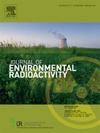福岛第一核电站事故初期131I物化组成比及地表沉降131I再排放过程对大气浓度的影响:三维大气弥散模拟方法
IF 2.1
3区 环境科学与生态学
Q3 ENVIRONMENTAL SCIENCES
引用次数: 0
摘要
本研究利用化学输运模型(CTM)进行的三维大气扩散模拟,验证了先前报道的福岛第一核电站(FDNPS)事故中释放的131I羽流的初始物理化学成分比。利用这些报告的比率,我们模拟了131I的有机气体、无机气体和颗粒形式的空气浓度,并将气态和颗粒形式的相对丰度与福岛县邻近地区茨城县收集的观测数据进行了比较。模拟大体上与观测结果一致,显示了与3月15日午夜前后释放的观测结果显著改善的一致性。当使用先前提出的用于FDNPS事故的131I源项时,基于这些初始组成比对源项进行细化是有益的。随后,我们研究了131I再排放过程对空气浓度的影响。CTM模拟结果显示,3月17日至19日观测站点的大气浓度主要受地表沉降再排放的影响。模拟中使用的再排放参数表明,表面沉积的直接挥发是FDNPS事故中131I再排放过程的关键机制。先前对FDNPS事故后131I的源项估计没有考虑再排放,这限制了观测数据的有效利用。这项研究的结果有望改善观测数据在未来评估中的整合。本文章由计算机程序翻译,如有差异,请以英文原文为准。
Initial 131I physicochemical composition ratios during the Fukushima Daiichi nuclear power station accident and impact of 131I re-emission process from surface deposition on air concentrations: three-dimensional atmospheric dispersion simulation approach
This study validated previously reported initial physicochemical composition ratios of 131I plumes released during the Fukushima Daiichi Nuclear Power Station (FDNPS) accident using three-dimensional atmospheric dispersion simulations performed with a chemical transport model (CTM). Using these reported ratios, we simulated air concentrations of organic gas, inorganic gas, and particulate forms of 131I and compared the relative abundance of gaseous and particulate forms with observational data collected in Ibaraki prefecture, a neighboring region of Fukushima prefecture. Simulations were generally consistent with observations, demonstrating significantly improved agreement with observations for releases occurring around midnight on March 15. Refining the source term based on these initial composition ratios is beneficial when utilizing a previously proposed 131I source term for the FDNPS accident. Subsequently, we investigated the influence of 131I re-emission processes on air concentrations. Simulations using the CTM revealed that air concentrations at the observation site from March 17 to 19 were largely influenced by re-emission from surface deposition. The re-emission parameter used in our simulations suggests that direct volatilization from surface deposition is a key mechanism in the 131I re-emission process during the FDNPS accident. Previous source term estimates of 131I following the FDNPS accident did not account for re-emission, which limited the effective use of observational data. The findings of this study are expected to improve the integration of observational data into future assessments.
求助全文
通过发布文献求助,成功后即可免费获取论文全文。
去求助
来源期刊

Journal of environmental radioactivity
环境科学-环境科学
CiteScore
4.70
自引率
13.00%
发文量
209
审稿时长
73 days
期刊介绍:
The Journal of Environmental Radioactivity provides a coherent international forum for publication of original research or review papers on any aspect of the occurrence of radioactivity in natural systems.
Relevant subject areas range from applications of environmental radionuclides as mechanistic or timescale tracers of natural processes to assessments of the radioecological or radiological effects of ambient radioactivity. Papers deal with naturally occurring nuclides or with those created and released by man through nuclear weapons manufacture and testing, energy production, fuel-cycle technology, etc. Reports on radioactivity in the oceans, sediments, rivers, lakes, groundwaters, soils, atmosphere and all divisions of the biosphere are welcomed, but these should not simply be of a monitoring nature unless the data are particularly innovative.
 求助内容:
求助内容: 应助结果提醒方式:
应助结果提醒方式:


